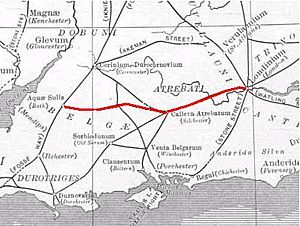Roman road from Silchester to Bath facts for kids

The Roman road from Silchester to Bath was an important ancient road in England. It connected two major Roman towns: Calleva Atrebatum (now Silchester) and Aquae Sulis (now Bath). This road also passed through other smaller Roman settlements like Spinae (near Speen), Cunetio, and Verlucio (close to Sandy Lane).
This road was a very busy route for people traveling east to west across southern England. It was also crucial for the Roman army to move soldiers and supplies between the 1st and 5th centuries AD.
Contents
What Was This Roman Road For?
The Roman Empire built many roads to help them control their lands and move around easily. This particular road was vital for several reasons:
- Connecting Important Towns: It linked Calleva Atrebatum, a large Roman town and a crossroads, with Aquae Sulis, famous for its natural hot springs and temples.
- Moving Soldiers: The Roman army used it to quickly move troops and equipment, which was important for keeping peace and defending their territory.
- Trade and Travel: Merchants used the road to transport goods, and ordinary people traveled on it for various reasons.
The Road's Journey
The road stretched for many miles, connecting key places.
From Silchester to Speen
Starting at Calleva Atrebatum (Silchester), the road headed west. Silchester was a very important Roman town, almost like a small city, with walls and many buildings.
Through Cunetio and Verlucio
The road continued through smaller Roman settlements like Cunetio and Verlucio. These places likely served as stops for travelers to rest, get fresh water, or change horses.
Arriving at Bath
Finally, the road reached Aquae Sulis (Bath). This town was famous throughout the Roman Empire for its natural hot springs, which the Romans turned into impressive public baths and temples. People came from all over to use the healing waters.
The Road After Roman Times
Even after the Romans left Britain in the 5th century, this road continued to be used.
Wansdyke and the Road
Parts of the Roman road were later used as a base for building Wansdyke. Wansdyke is a large, ancient ditch and bank earthwork that stretches across parts of Wiltshire and Somerset. Historians believe it was built for defense or to mark a boundary.
Medieval Travelers
During the Middle Ages, the road was still important.
- Drovers: People called "drovers" used it to move their livestock, like sheep and cattle, from one place to another for sale.
- Merchants and Travelers: Just like in Roman times, merchants continued to use the road for trade, and other travelers used it to get around.
Where Can You See It Today?
Today, some parts of the ancient Roman road are still visible. You might find stretches of it as old tracks or paths. In other places, however, there are no clear signs left, and the road is hidden beneath fields or modern buildings. Archaeologists and historians continue to study these ancient routes to learn more about Roman Britain.

